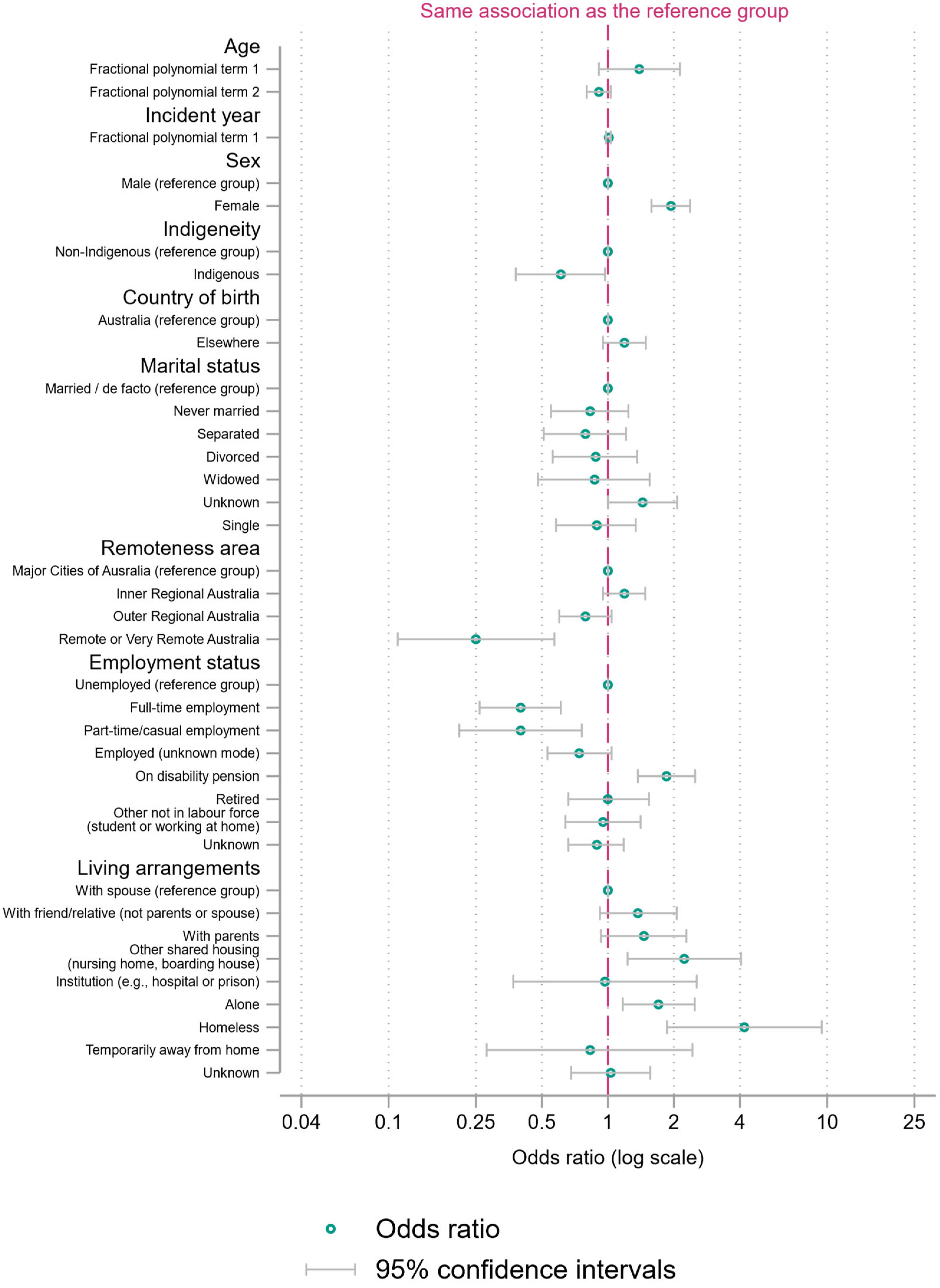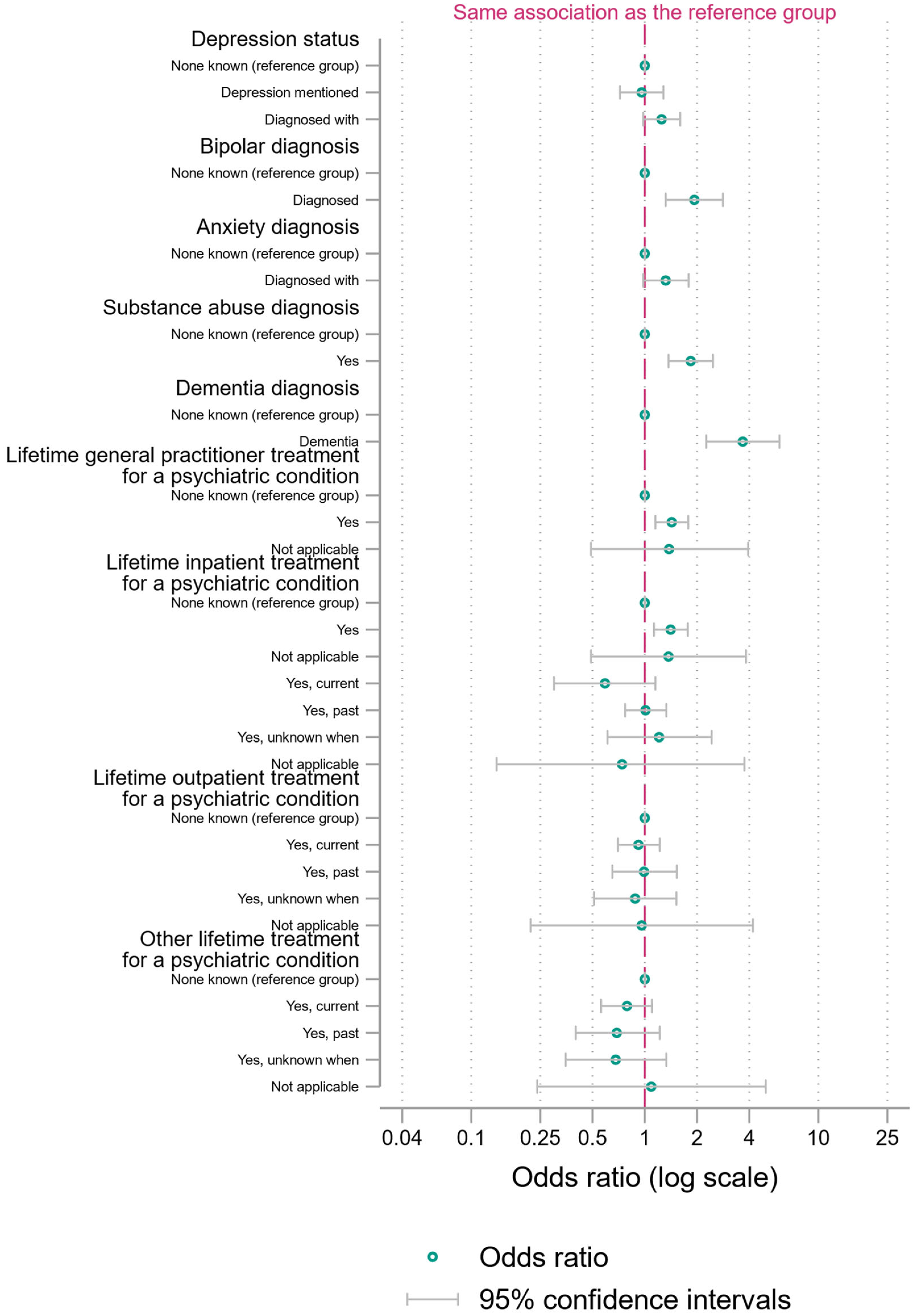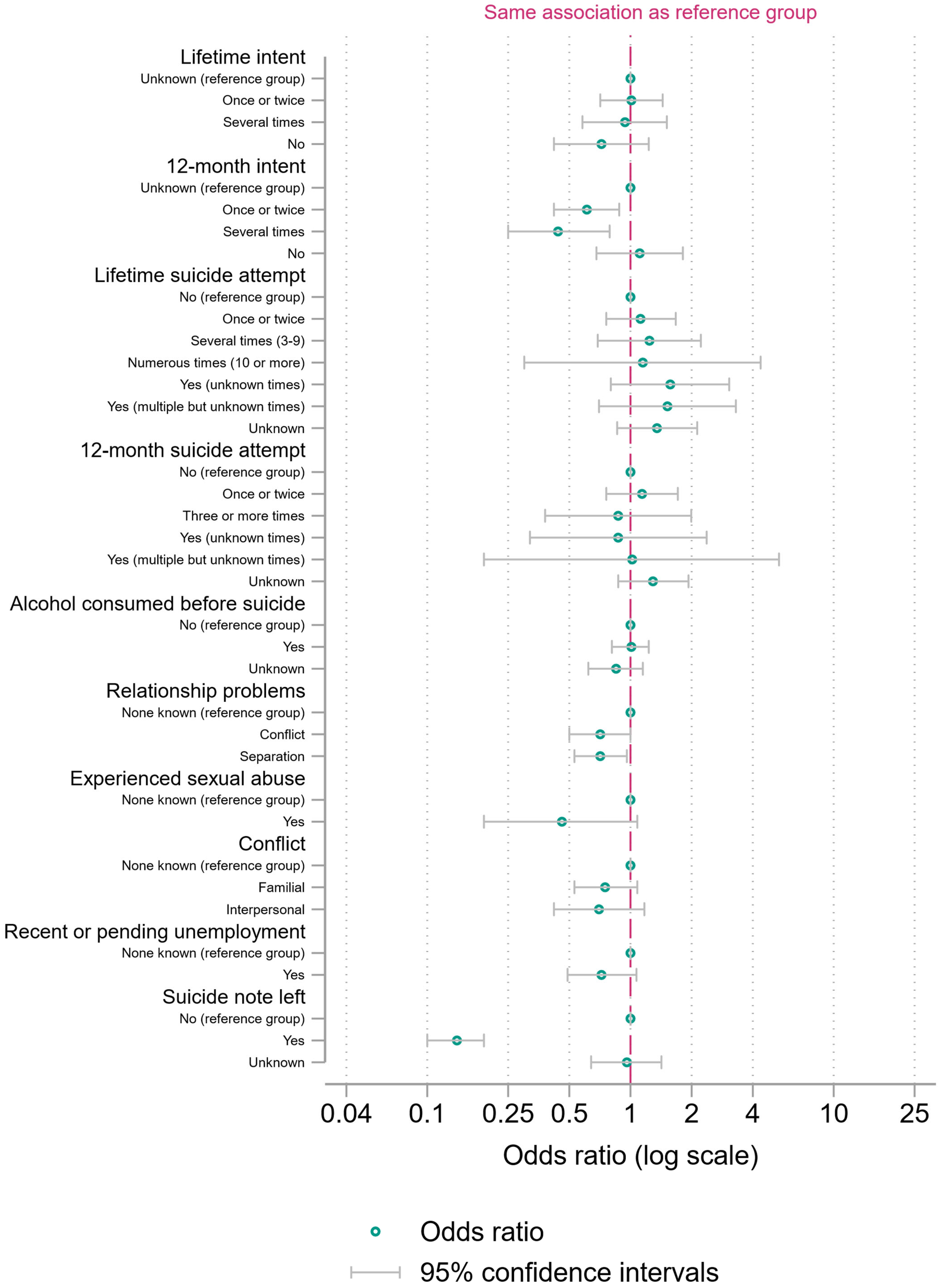Why Do We Agree to Disagree? Agreement and Reasons for Disagreement in Judgements of Intentional Self-Harm from Coroners and a Suicide Register in Queensland, Australia, from 2001 to 2015
Abstract
1. Introduction
2. Materials and Methods
2.1. Study Design and Data Sources
2.2. Statistical Analysis
2.3. Ethics
2.4. Reporting Guidelines
3. Results
4. Discussion
5. Conclusions
Supplementary Materials
Author Contributions
Funding
Institutional Review Board Statement
Informed Consent Statement
Data Availability Statement
Acknowledgments
Conflicts of Interest
References
- Harrison, J.E.; Pointer, S.; Elnour, A. A Review of Suicide Statistics in Australia; AIHW: Canberra, Australia, 2009. [Google Scholar]
- Bradley, C.E.; Harrison, J.E.; Abou Elnour, A. Appearances May Deceive: What’s Going on with Australian Suicide Statistics? Med. J. Aust. 2010, 192, 428–429. [Google Scholar] [CrossRef] [PubMed]
- de Leo, D.; Dudley, M.J.; Aebersold, C.J.; Mendoza, J.A.; Barnes, M.A.; Harrison, J.E.; Ranson, D.L. Achieving Standardised Reporting of Suicide in Australia: Rationale and Program for Change. Med. J. Aust. 2010, 192, 452–456. [Google Scholar] [CrossRef] [PubMed]
- Tait, G.; Jowett, S.; Carpenter, B. Coronial Decision-Making and the Management, Classification and Conceptualisation of the Finding of ‘Suicide’. Mortality 2020, 25, 297–312. [Google Scholar] [CrossRef]
- Sveticic, J.; McPhedran, S.; de Leo, D. Reviewing the Revisions: What Are the Australian Bureau of Statistics Suicide Figures Really Telling Us? Med. J. Aust. 2013, 198, 478. [Google Scholar] [CrossRef] [PubMed][Green Version]
- Farrow, R.; Arensman, E.; Corcoran, P.; Williamson, E.; Perry, I.J. Irish Coroners’ Attitudes towards Suicide and Its Prevention. Ir. J. Med. Sci. 2009, 178, 61–67. [Google Scholar] [CrossRef]
- Jowett, S.; Carpenter, B.; Tait, G. Determining a Suicide under Australian Law: A Comparative Study of Coronial Practice. Univ. New South. Wales Law. J. 2020, 42, 534–556. [Google Scholar] [CrossRef]
- Rockett, I.; Kapusta, N.; Bhandari, R. Suicide Misclassification in an International Context: Revisitation and Update. Suicidol. Online 2011, 2, 48–61. [Google Scholar]
- Williams, R.F.G.; Doessel, D.P.; Sveticic, J.; de Leo, D. Accuracy of Official Suicide Mortality Data in Queensland. Aust. N. Z. J. Psychiatry 2010, 44, 815–822. [Google Scholar] [CrossRef]
- Bakst, S.S.; Braun, T.; Zucker, I.; Amitai, Z.; Shohat, T. The Accuracy of Suicide Statistics: Are True Suicide Deaths Misclassified? Soc. Psychiatry Psychiatr. Epidemiol. 2016, 51, 115–123. [Google Scholar] [CrossRef]
- Tøllefsen, I.M.; Hem, E.; Ekeberg, Ø. The Reliability of Suicide Statistics: A Systematic Review. BMC Psychiatry 2012, 12, 9. [Google Scholar] [CrossRef]
- Leske, S.; Garrett, A.; Dwyer, J. It Is Official, They Are Different–Discrepancies between National Statistical Agency and Register-Based State Suicide Mortality Statistics in Australia. Crisis J. Crisis Interv. Suicide Prev. 2022, 44, 389–397. [Google Scholar] [CrossRef] [PubMed]
- Austin, A.E.; van den Heuvel, C.; Byard, R.W. Differences in Local and National Database Recordings of Deaths from Suicide. Forensic Sci. Med. Pathol. 2017, 13, 403–408. [Google Scholar] [CrossRef] [PubMed]
- De Leo, D. Suicide Mortality Data Need Revision. Med. J. Aust. 2007, 186, 157–158. [Google Scholar] [CrossRef] [PubMed]
- Milner, A.J.; Maheen, H.; Bismark, M.M.; Spittal, M.J. Suicide by Health Professionals: A Retrospective Mortality Study in Australia, 2001–2012. Med. J. Aust. 2016, 205, 260–265. [Google Scholar] [CrossRef] [PubMed]
- Milner, A.; Witt, K.; Maheen, H.; LaMontagne, A. Access to Means of Suicide, Occupation and the Risk of Suicide: A National Study over 12 Years of Coronial Data. BMC Psychiatry 2017, 17, 125. [Google Scholar] [CrossRef] [PubMed]
- Maheen, H.; Taouk, Y.; LaMontagne, A.D.; Spittal, M.; King, T. Suicide Trends among Australian Construction Workers during Years 2001–2019. Sci. Rep. 2022, 12, 20201. [Google Scholar] [CrossRef] [PubMed]
- Milner, A.; Witt, K.; Maheen, H.; LaMontagne, A.D. Suicide among Emergency and Protective Service Workers: A Retrospective Mortality Study in Australia, 2001 to 2012. Work 2017, 57, 281–287. [Google Scholar] [CrossRef]
- Milner, A.; Niven, H.; LaMontagne, A. Suicide by Occupational Skill Level in the Australian Construction Industry: Data from 2001 to 2010. Aust. N. Z. J. Public Health 2014, 38, 281–285. [Google Scholar] [CrossRef]
- Milner, A.; Niven, H.; Page, K.; LaMontagne, A. Suicide in Veterinarians and Veterinary Nurses in Australia: 2001–2012. Aust. Vet. J. 2015, 93, 308–310. [Google Scholar] [CrossRef]
- Petrie, K.; Zeritis, S.; Phillips, M.; Chen, N.; Shand, F.; Spittal, M.J.; Harvey, S.B. Suicide among Health Professionals in Australia: A Retrospective Mortality Study of Trends over the Last Two Decades. Aust. N. Z. J. Psychiatry 2023, 57, 983–993. [Google Scholar] [CrossRef]
- Hill, N.T.; Witt, K.; Rajaram, G.; McGorry, P.D.; Robinson, J. Suicide by Young Australians, 2006–2015: A Cross-Sectional Analysis of National Coronial Data. Med. J. Aust. 2021, 214, 133–139. [Google Scholar] [CrossRef] [PubMed]
- Dodds, L.; Robinson, K.M.; Daking, L.; Paul, L. The Concept of “intent” within Australian Coronial Data: Factors Affecting the National Coronial Information System’s Classification of Mortality Attributable to Intentional Self-Harm. Health Inf. Manag. 2014, 43, 13–22. [Google Scholar] [CrossRef] [PubMed]
- Daking, L.; Dodds, L. ICD-10 Mortality Coding and the NCIS: A Comparative Study. HIM J. 2007, 36, 11–23. [Google Scholar] [CrossRef] [PubMed]
- Elnour, A.A.; Harrison, J. Suicide Decline in Australia: Where Did the Cases Go? Aust. N. Z. J. Public Health 2009, 33, 67–69. [Google Scholar] [CrossRef] [PubMed]
- Pearse, J.D. Achieving Standardised Reporting of Suicide in Australia: Rationale and Program for Change. Med. J. Aust. 2010, 193, 191. [Google Scholar] [CrossRef] [PubMed]
- Pearse, J.; Daking, L. A Response to Bugeja, Clapperton, Killian, Stephan and Ozanne-Smith. Health Inf. Manag. J. 2010, 39, 27–28. [Google Scholar] [CrossRef] [PubMed]
- Palmer, B.S.; Bennewith, O.; Simkin, S.; Cooper, J.; Hawton, K.; Kapur, N.; Gunnell, D. Factors Influencing Coroners’ Verdicts: An Analysis of Verdicts given in 12 Coroners’ Districts to Researcher-Defined Suicides in England in 2005. J. Public Health 2015, 37, 157–165. [Google Scholar] [CrossRef]
- Appleby, L.; Turnbull, P.; Kapur, N.; Gunnell, D.; Hawton, K. New Standard of Proof for Suicide at Inquests in England and Wales. BMJ 2019, 366, l4745. [Google Scholar] [CrossRef]
- Australian Bureau of Statistics. Causes of Death, Australia. 2021. Available online: https://www.abs.gov.au/statistics/health/causes-death/causes-death-australia/latest-release (accessed on 15 July 2023).
- National Coronial Information System. System Manuals. Available online: https://www.ncis.org.au/about-the-data/system-manuals (accessed on 15 July 2023).
- Leske, S.; Adam, G.; Catakovic, A.; Weir, B.; Kõlves, K. Annual Report. 2022. Available online: https://www.griffith.edu.au/griffith-health/australian-institute-suicide-research-prevention/research/qsr/annual-report-2022 (accessed on 15 July 2023).
- Coroners Court of Queensland Form 1 Police Report of Death to a Coroner. Available online: https://www.courts.qld.gov.au/__data/assets/pdf_file/0004/138766/form1-police-report-of-death.pdf (accessed on 12 August 2023).
- Coroners Court of Queensland Form 20A, Version 2, Coroner’s Findings and Notice of Completion of Coronial Investigation. Available online: https://www.courts.qld.gov.au/__data/assets/pdf_file/0011/87842/Form-20A-coroners-findings-and-notice-of-completion-of-coronial-investigation.pdf (accessed on 12 August 2023).
- Brennan, R.L.; Prediger, D.J. Coefficient Kappa: Some Uses, Misuses, and Alternatives. Educ. Psychol. Meas. 1981, 41, 687–699. [Google Scholar] [CrossRef]
- Cohen, J. A Coefficient of Agreement for Nominal Scales. Educ. Psychol. Meas. 1960, 20, 37–46. [Google Scholar] [CrossRef]
- Cohen, J. Weighted Kappa: Nominal Scale Agreement Provision for Scaled Disagreement or Partial Credit. Psychol. Bull. 1968, 70, 213–220. [Google Scholar] [CrossRef] [PubMed]
- Conger, A.J. Integration and Generalization of Kappas for Multiple Raters. Psychol. Bull. 1980, 88, 322–328. [Google Scholar] [CrossRef]
- Scott, W.A. Reliability of Content Analysis: The Case of Nominal Scale Coding. Public Opin. Q. 1955, 19, 321–325. [Google Scholar] [CrossRef]
- Fleiss, J.L. Measuring Nominal Scale Agreement among Many Raters. Psychol. Bull. 1971, 76, 378–382. [Google Scholar] [CrossRef]
- Gwet, K.L. Computing Inter-Rater Reliability and Its Variance in the Presence of High Agreement. Br. J. Math. Stat. Psychol. 2008, 61, 29–48. [Google Scholar] [CrossRef] [PubMed]
- Gwet, K.L. Handbook of Inter-Rater Reliability: The Definitive Guide to Measuring the Extent of Agreement Among Raters, 4th ed.; Advanced Analytics: Gaithersburg, MD, USA, 2014; ISBN 978-0-9708062-8-4. [Google Scholar]
- Krippendorff, K. Estimating the Reliability, Systematic Error and Random Error of Interval Data. Educ. Psychol. Meas. 1970, 30, 61–70. [Google Scholar] [CrossRef]
- Krippendorff, K. Computing Krippendorff’s Alpha-Reliability; University of Pennsylvania: Philadelphia, PA, USA, 2011; Available online: https://repository.upenn.edu/server/api/core/bitstreams/0421f871-f005-4322-b06a-a66bec328e3b/content (accessed on 19 December 2023).
- Krippendorff, K. Content Analysis: An Introduction to Its Methodology; SAGE Publications: Thousand Oaks, CA, USA, 2018; ISBN 978-1-5063-9567-8. [Google Scholar] [CrossRef]
- StataCorp. Stata Statistical Software, Version 13.1; StataCorp LLC: College Station, TX, USA, 2013.
- Medeiros, R.A.; Blanchette, D. MDESC: Stata Module to Tabulate Prevalence of Missing Values. Boston College Department of Economics: Chestnut Hill, MA, USA, 2011. [Google Scholar]
- Ender, P.B. Collin. Collinearity Diagnostics. Statistical Computing and Consulting, UCLA Office of Academic Computing: Los Angeles, CA, USA, 2010; Available online: https://stats.oarc.ucla.edu/stata/ado/analysis/ (accessed on 19 December 2023).
- Weber, S. Bacon: An Effective Way to Detect Outliers in Multivariate Data Using Stata (and Mata). Stata J. 2010, 10, 331–338. [Google Scholar] [CrossRef]
- Billor, N.; Hadi, A.S.; Velleman, P.F. BACON: Blocked adaptive computationally efficient outlier nominators. Comput. Stat. Data Anal. 2000, 34, 279–298. [Google Scholar] [CrossRef]
- Klein, D. Implementing a general framework for assessing interrater agreement in Stata. Stata J. 2018, 18, 871–901. [Google Scholar] [CrossRef]
- Shah, A. ASDOC: Stata Module to Create High-Quality Tables in MS Word from Stata Output; Statistical Software Components S458466; Boston College Department of Economics: Boston, MA, USA, 2018. [Google Scholar]
- Vandenbroucke, J.P.; von Elm, E.; Altman, D.G.; Gøtzsche, P.C.; Mulrow, C.D.; Pocock, S.J.; Poole, C.; Schlesselman, J.J.; Egger, M. STROBE Initiative. Strengthening the Reporting of Observational Studies in Epidemiology (STROBE): Explanation and elaboration. PLoS Med. 2007, 4, e297. [Google Scholar] [CrossRef]
- Benchimol, E.I.; Smeeth, L.; Guttmann, A.; Harron, K.; Moher, D.; Petersen, I.; Sørensen, H.T.; von Elm, E.; Langan, S.M. The REporting of studies Conducted using Observational Routinely-collected health Data (RECORD) Statement. PLoS Med. 2015, 12, e1001885. [Google Scholar] [CrossRef] [PubMed]
- Fleiss, J.L. Statistical Methods for Rates and Proportions, 2nd ed.; Wiley Series in Probability and Mathematical Statistics; Wiley: New York, NY, USA, 1981; ISBN 978-0-471-06428-2. [Google Scholar]
- Cicchetti, D.V.; Sparrow, S.A. Developing Criteria for Establishing Interrater Reliability of Specific Items: Applications to Assessment of Adaptive Behavior. Am. J. Ment. Defic. 1981, 86, 127–137. [Google Scholar] [PubMed]
- Regier, D.A.; Narrow, W.E.; Clarke, D.E.; Kraemer, H.C.; Kuramoto, S.J.; Kuhl, E.A.; Kupfer, D.J. DSM-5 Field Trials in the United States and Canada, Part II: Test-Retest Reliability of Selected Categorical Diagnoses. AJP 2013, 170, 59–70. [Google Scholar] [CrossRef] [PubMed]
- Landis, J.R.; Koch, G.G. An Application of Hierarchical Kappa-Type Statistics in the Assessment of Majority Agreement among Multiple Observers. Biometrics 1977, 33, 363–374. [Google Scholar] [CrossRef]
- Landis, J.R.; Koch, G.G. The Measurement of Observer Agreement for Categorical Data. Biometrics 1977, 33, 159. [Google Scholar] [CrossRef]
- Cox, G.; Munnelly, A.; Rochford, S.; Kavalidou, K. Irish Probable Suicide Deaths Study (IPSDS) 2015–2018; HSE National Office for Suicide Prevention: Dublin, Ireland, 2022. [Google Scholar]
- Cox, K.L.; Nock, M.K.; Biggs, Q.M.; Bornemann, J.; Colpe, L.J.; Dempsey, C.L.; Heeringa, S.G.; McCarroll, J.E.; Ng, T.H.; Schoenbaum, M.; et al. An Examination of Potential Misclassification of Army Suicides: Results from the Army Study to Assess Risk and Resilience in Service members. Suicide Life Threat. Behav. 2017, 47, 257–265. [Google Scholar] [CrossRef]



| Intentional Self-Harm in the National Coronial Information System | ||||||
|---|---|---|---|---|---|---|
| Queensland Suicide Register Dichotomous Variable for Suicide | Yes—n | Yes—% | No—n | No—% | Total—n | Total—% |
| Not suicide | 87 | 1.0 | 439 | 42.4 | 526 | 5.6 |
| Suicide | 8304 | 99.0 | 597 | 57.6 | 8901 | 94.4 |
| Measure of Agreement | Coefficient | SE | T-Value | p-Value | 95% CI LL | 95% CI UL | Level of Agreement |
|---|---|---|---|---|---|---|---|
| Percent Agreement | 0.93 | <0.01 | 327.3 | <0.001 | 0.92 | 0.93 | Excellent [55,56,57] or almost perfect [58,59] |
| Gwet’s AC1 | 0.91 | <0.01 | 261.7 | <0.001 | 0.91 | 0.92 | |
| Brennan and Prediger | 0.85 | 0.01 | 157.9 | <0.001 | 0.84 | 0.87 | |
| Cohen/Conger’s Kappa | 0.53 | 0.02 | 33.9 | <0.001 | 0.50 | 0.56 | Fair [56], fair to good [55], moderate [58,59], or good [57] |
| Krippendorff’s Alpha (preferred) | 0.52 | 0.02 | 32.6 | <0.001 | 0.49 | 0.55 | |
| Scott/Fleiss’ Pi | 0.52 | 0.02 | 32.4 | <0.001 | 0.49 | 0.55 |
Disclaimer/Publisher’s Note: The statements, opinions and data contained in all publications are solely those of the individual author(s) and contributor(s) and not of MDPI and/or the editor(s). MDPI and/or the editor(s) disclaim responsibility for any injury to people or property resulting from any ideas, methods, instructions or products referred to in the content. |
© 2023 by the authors. Licensee MDPI, Basel, Switzerland. This article is an open access article distributed under the terms and conditions of the Creative Commons Attribution (CC BY) license (https://creativecommons.org/licenses/by/4.0/).
Share and Cite
Leske, S.; Weir, B.; Adam, G.; Kõlves, K. Why Do We Agree to Disagree? Agreement and Reasons for Disagreement in Judgements of Intentional Self-Harm from Coroners and a Suicide Register in Queensland, Australia, from 2001 to 2015. Int. J. Environ. Res. Public Health 2024, 21, 52. https://doi.org/10.3390/ijerph21010052
Leske S, Weir B, Adam G, Kõlves K. Why Do We Agree to Disagree? Agreement and Reasons for Disagreement in Judgements of Intentional Self-Harm from Coroners and a Suicide Register in Queensland, Australia, from 2001 to 2015. International Journal of Environmental Research and Public Health. 2024; 21(1):52. https://doi.org/10.3390/ijerph21010052
Chicago/Turabian StyleLeske, Stuart, Bridget Weir, Ghazala Adam, and Kairi Kõlves. 2024. "Why Do We Agree to Disagree? Agreement and Reasons for Disagreement in Judgements of Intentional Self-Harm from Coroners and a Suicide Register in Queensland, Australia, from 2001 to 2015" International Journal of Environmental Research and Public Health 21, no. 1: 52. https://doi.org/10.3390/ijerph21010052
APA StyleLeske, S., Weir, B., Adam, G., & Kõlves, K. (2024). Why Do We Agree to Disagree? Agreement and Reasons for Disagreement in Judgements of Intentional Self-Harm from Coroners and a Suicide Register in Queensland, Australia, from 2001 to 2015. International Journal of Environmental Research and Public Health, 21(1), 52. https://doi.org/10.3390/ijerph21010052






